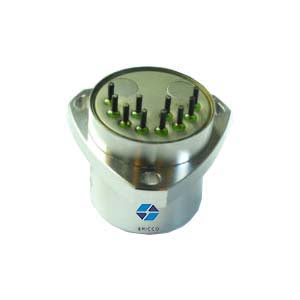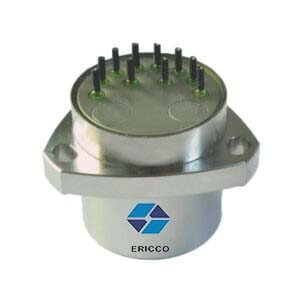Reliability is crucial for success in the challenging oil and gas industry, where risks are frequent and can significantly impact opportunities. Dependable, precise data can determine whether a venture succeeds or fails.
Ericco has been supplying robust sensing products to the global oil and gas sector, proving their exceptional reliability and accuracy in some of the world’s most demanding environments.
1.What are high temperature accelerometers?
High temperature accelerometers are designed to withstand harsh conditions and provide accurate data in demanding industries such as aerospace and oil & gas. Essentially, their purpose is to function effectively in challenging environments, including underground settings and extreme temperatures.
Manufacturers of high temperature accelerometers employ specific technologies to ensure the sensors' reliability in extreme conditions. For instance, Ericco’s Quartz Accelerometer for Oil and Gas is proved to own high performance. This model utilizes an amorphous quartz proof-mass structure that reacts to acceleration through flexure motion, ensuring excellent stability in bias, scale factor, and axis alignment.
2.How are high temperature accelerometers used?
High temperature accelerometers are vital in industries where equipment must endure extreme conditions. Their robust design and advanced technology enable them to operate reliably in harsh environments, providing crucial data that enhances safety, efficiency, and performance. Here’s a closer look at their applications and significance:
2.1 Oil & Gas Industry
In the oil & gas industry, high temperature accelerometers are essential components of Measurement While Drilling (MWD) systems. MWD is a well logging technique that uses sensors within the drillstring to provide real-time data, guiding the drill and optimizing drilling operations. These accelerometers can withstand the intense heat, shock, and vibrations encountered deep underground. By delivering accurate measurements, they help:
- Optimize Drilling Operations: Provide precise data on the drill bit's orientation and position, aiding in efficient and accurate drilling.
- Enhance Safety: Detect vibrations and shocks that could indicate potential issues, allowing for timely intervention and prevention of accidents.
- Improve Efficiency: Reduce downtime by providing continuous, reliable data that helps prevent operational failures and costly interruptions.

2.2 Aerospace
In the aerospace industry, high temperature accelerometers are used to monitor the performance and structural integrity of aircraft. They can endure the extreme conditions of flight, including high temperatures and intense vibrations, and are crucial for:
- Structural Health Monitoring: Measure vibrations and stresses on aircraft components, ensuring they remain within safe limits.
- Engine Performance: Monitor vibrations in aircraft engines to detect anomalies and prevent engine failures.
- Flight Testing: Provide accurate data on aircraft dynamics during test flights, aiding in the development and refinement of aircraft designs.
2.3 Automotive Testing
In automotive testing, high temperature accelerometers are employed to measure vehicle dynamics and structural integrity under extreme conditions. They are particularly useful for:
- Crash Testing: Monitor acceleration and deceleration forces during crash tests to evaluate vehicle safety and crashworthiness.
- High-Performance Testing: Measure vibrations and stresses in high-performance vehicles to ensure components can withstand extreme driving conditions.
- Durability Testing: Assess the long-term durability of automotive components by subjecting them to prolonged high temperatures and vibrations.
2.4 Industrial Applications
Beyond oil & gas, aerospace, and automotive industries, high temperature accelerometers are also used in various other industrial applications where equipment operates in extreme conditions. These include:
- Power Generation: Monitor vibrations in turbines and other equipment to ensure optimal performance and prevent failures.
- Manufacturing: Measure vibrations and stresses in heavy machinery to maintain operational efficiency and safety.
- Robotics: Provide precise data on the movements and stresses experienced by robots operating in high-temperature environments, such as those used in welding or foundries.
3.Ericco's High Temperature Accelerometers
Ericco has excelled in designing and manufacturing high-temperature accelerometers that meet the demanding requirements of these industries. We offer solutions tailored for energy exploration and other high-temperature applications. These accelerometers feature:
- Analog Output: For easy integration with existing systems.
- Mounting Options: Square or round flanges to suit different installation needs.
- Field-Adjustable Range: Allowing customization to specific application requirements.
- Internal Temperature Sensors: For thermal compensation, ensuring accurate measurements despite temperature variations.
What's more, Ericco’s Quartz Accelerometer for Oil and Gas is proved to own high performance. This model utilizes an amorphous quartz proof-mass structure that reacts to acceleration through flexure motion, ensuring excellent stability in bias, scale factor, and axis alignment.
Some high temperature accelerometers also incorporate external amplifiers to safeguard the sensor from heat damage.
And we recommend the ER-QA-03D for oil and gas, whose operating temperature is -55~180 ℃, with an input range of ±30g, bias repeatability <50μg, and scale factor repeatability <80 ppm.
4.Conclusion
High temperature accelerometers are indispensable in industries that operate under extreme conditions. Their ability to provide reliable and accurate data in such environments enhances operational efficiency, safety, and performance. With advancements in technology, these sensors continue to evolve, offering even greater reliability and precision in the most demanding applications.
More Technical Questions
1. Full-temperature Performance Optimization Method For MEMS accelerometer
2. A Closed-loop Test Method for Damping Coefficient of Q-Flex Accelerometer
3. Driving Automotive Evolution: MEMS Accelerometers
4. Factors Affecting the Stability of Q-Flex Accelerometers
5. Structure Design of High Precision Quartz Flexible Accelerometer
6. Methods to Maintain the Long-Term Performance of Quartz Flexure Accelerometers







